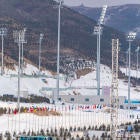
The 2022 Beijing Winter Olympics are the first games to use 100 percent artificial snow. Many fans have noticed the abundance of artificial snow, wondering why they are completely relying on the fake stuff and how the athletes feel about it. As far as the "why" goes, fake snow was the plan ever since Beijing was awarded the Winter Olympics. The area simply doesn't get a ton of snow annually.
In order to create enough snow for the events, Yahoo Sports reported that there are over 100 snow generators and 300 snow-cannons to cover the ski slopes. Those machines have helped created over 1.2 million cubic meters of snow to ensure the athletes have enough for each winter event.
While fake snow is a solution that allows the Games to go on as scheduled, it has become a controversial topic. There are some that see issue with the artificial precipitation, from athletes to those concerned about the environment, while others are fine with it.
American skiing star Mikaela Shiffrin has failed to qualify for both the slalom and giant slalom events in Beijing -- events she has won at past Olympics -- but is not blaming the fake snow.
"I feel that it's incredible," Shiffrin, who fell in the qualifying rounds of both events, told Sports Illustrated.
Australian snowboarder Matt Cox also likes the fake snow, saying, "The snow is super grippy here. Also ... because usually when you get to man-made snow and you rip into an edge, for instance, it slides out on you pretty easily, but with the cold temps here, it's dreamy snow."
However, Estonian biathlete Johanna Taliharm says it is "dangerous."
"Artificial snow is icier, therefore faster and more dangerous," Taliharm said. "It also hurts more if you fall outside of the course when there is no fluffy snowbank, but a rocky and muddy hard ground."
Chris Grover, head cross country coach for the U.S. Ski Team, agrees that falling on the fake snow hurts more.
"It can be really rock hard out there and falling can feel like falling on concrete, and so it does make it a little bit more dangerous than if it was natural snow conditions," he told the Globe and Mail.
Michael Mayr, the Area Manager of Asia TechnoAlpin (the company making the snow machines being used at the Beijing Games), explained to Time Magazine that there are certain advantages to fake snow. Notably, the machines can generate different types of snow depending on what the event calls for.
"For the alpine venues, we need very icy snow," Mayr told Time. "On the freestyle venues, we need a little bit softer snow. We thus can set the quality [for all] all of that. It's the perfect snow for athletes."
Outside of just these Winter Games in Beijing, Time Magazine noted that this all could be a concerning sign for the future of the Winter Olympics. If areas in the world warm too much over time, it could create issues that even artificial snow cannot cover up.
















